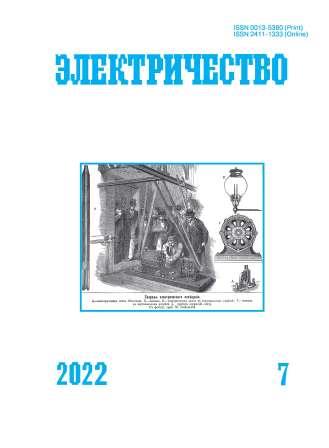Основы теории и расчет индукционного левитатора электротехнических устройств
DOI:
https://doi.org/10.24160/0013-5380-2022-7-68-75Ключевые слова:
индукционная система, левитационный элемент, рабочий ход, левитационная обмотка, коэффициент силы, токи, механическая силаАннотация
В статье изложены основы теории и расчета индукционного левитатора с короткозамкнутой обмоткой, который является главным элементом различных электротехнических устройств. Автоматизация технологических процессов часто требует автоматического управления вертикальным положением подвижной части рабочих механизмов с помощью внешней силы и напряжения переменного тока. При этом необходимы измерение внешней силы, стабилизация тока при переменной нагрузке и изменение значений номинального тока на нагрузке. Электромеханические преобразователи с левитационными элементами, несмотря на простоту конструкции, эффективно решают эти задачи. Автоматическое изменение напряжения на зажимах обмотки возбуждения позволяет плавно регулировать рабочий ход левитационной обмотки и положение рабочего механизма. Разработана математическая модель индукционного левитатора, описывающая соотношения магнитных, электрических, тепловых и механических цепей и позволяющая определить параметры индукционного левитатора. Изложена методика расчета индукционного левитатора со ступенчатым магнитопроводом. Полученные аналитические выражения могут быть использованы при расчете и проектировании электротехнических устройств различного назначения, содержащих левитационные обмотки.
Библиографические ссылки
2. Yaghoubi H. Practical Applications of Magnetic Levitation Technology. Iran Maglev Technology (IMT), Iran, 2012, pp. 1–56.
3. Абдуллаев Я.Р. Теория магнитных систем с электромагнитными экранами. М.: Наука, 2000, 288 с.
4. Кaplan B.Z., et al. Magnetic Levitation by Chaotic Oscillation: a New Method. – IEEE Transactions on Magnetics, 2002, vol. 38, No. 5, pp. 3475–3481, DOI: 10.1109/TMAG.2002.802707.
5. Пириева Н.М. Определение основных размеров ступенчатого индукционного левитатора. – Проблемы энергетики, 2013, № 1, с. 99–105.
6. Абдуллаев Я.Р. и др. Вопросы проектирования электромеханических преобразователей с левитационными элементами. – Известия высших учебных заведений. Электромеханика, 2018, т. 61, № 2, с. 47–52.
7. Абдуллаев Я.Р. Расчет левитационной обмотки. – Проблемы энергетики, 2011, № 3; с. 136–143.
8. Абдуллаев Я.Р. Электромагнитный расчет магнитных систем с подвижным экранами. – Электричество, 2007, № 12, с 31–40.
9. Абдуллаев Я.Р., Мамедова Г.В., Керимзаде Г.С. Расчет электромеханических силовых исполнительных преобразователей с левитационными экранами. – Электричество, 2007, № 3, с. 27–36.
10. Абдуллаев Я.Р., Мамедова Г.В., Керимзаде Г.С. Расчет многономинальных стабилизаторов переменного тока с левитационной обмоткой. – Электротехника, 2006, № 7, с. 20–28.
11. Абдуллаев Я.Р., Пириева Н.М. Расчет и проектирование управляемой индукционной опоры с левитационной обмоткой. – Известия высших учебных заведений. Электромеханика, 2015, № 5, с. 59–64.
12. Лыков А.В. Теория теплопроводности. М.: Высшая школа, 1967, 600 с.
13. Franz R., Wiedemann G. Ueber die Wärme-Leitungsfähigkeit der Metalle. – Annalen der Physik, 1853, vol. 165, pp. 497–531, DOI:10.1002/andp.18531650802.
14. Абдуллаев Я.Р. и др. Обобщенные показатели электромагнитных устройств с левитационными элементами. – Известия высших учебных заведений. Приборостроение, 2017, т. 60, № 5, с. 173–178.
15. Мамедова Г.В., Керимзаде Г.С. Проектирование электромеханических преобразователей с левитационным экраном. – Электротехника, 2019, № 5. c. 50–55.
16. Мамедова Г.В., Керимзаде Г.С. Анализ параметров электрических аппаратов с левитационнными элементами. – Известия высших учебных заведений. Приборостроение, 2018, т. 61, № 12, с. 67–71.
17. Мамедова Г.В. и др. Расчет электромеханических преобразователей с левитационными элементами с учетом ограничений на размеры. – Проблемы энергетики, 2017, № 3, с. 52–59.
18. Мамедова Г.В., Керимзаде Г.С. Методика учета факторов и определения геометрических размеров и параметров стабилизаторов переменного тока для состояния левитации. – Известия высших технических учебных заведений Азербайджана, 2015, № 5(99), с. 61– 65.
#
1. Han H.-S., Kim D.-S. Magnetic Levitation: Maglev Technology and Applications. New York: Springer, 2016, 247 p.
2. Yaghoubi H. Practical Applications of Magnetic Levitation Technology. Iran Maglev Technology (IMT), Iran, 2012, pp. 1–56.
3. Abdullaev Ya.R. Teoriya magnitnyh sistem s elektromagnitnymi ekranami (Theory of Magnetic Systems with Electromagnetic Screens). М.: Nauka, 2000, 288 p.
4. Кaplan B.Z., et al. Magnetic Levitation by Chaotic Oscillation: a New Method. – IEEE Transactions on Magnetics, 2002, vol. 38, No. 5, pp. 3475–3481, DOI: 10.1109/TMAG.2002.802707.
5. Pirieva N.М. Problemy energetiki – in Russ. (Power Engineering Problems), 2013, No. 1, pp. 99–105.
6. Abdullaev Ya.R., et al. Izvestiya vysshih uchebnyh zavedeniy. Elektromekhanika – in Russ. (News of Higher Educational Institutions. Electromechanics), 2018, vol. 61, No. 2, pp. 47–52.
7. Abdullaev Ya.R. Problemy energetiki – in Russ. (Power Engineering Problems), 2011, No. 3; pp. 136–143.
8. Abdullaev Ya.R. Elektrichestvo – in Russ. (Electricity), 2007, No. 12, pp 31–40.
9. Abdullaev Ya.R., Mamedova G.V., Kerimzade G.S. Elektrichestvo – in Russ. (Electricity), 2007, No. 3, pp.27–36.
10. Abdullaev Ya.R., Mamedova G.V., Kerimzade G.S. Elektrotekhnika – in Russ. (Electrical Engineering), 2006, No. 7, pp.20–28.
11. Abdullaev Ya.R., Pirieva N.М. Izvestiya vysshih uchebnyh zavedeniy. Elektromekhanika – in Russ. (News of Higher Educational Institutions. Electromechanics), 2015, No. 5, pp. 59–64.
12. Lykov А.V. Teoriya teploprovodnosti (Theory of Thermal Conductivity). М.: Vysshaya shkola, 1967, 600 p.
13. Franz R., Wiedemann G. Ueber die Wärme-Leitungsfähigkeit der Metalle. – Annalen der Physik, 1853, vol. 165, pp. 497–531, DOI:10.1002/andp.18531650802.
14. Abdullaev Ya.R., et al. Izvestiya vysshih uchebnyh zavedeniy..Priborostroenie – in Russ. (News of Higher Educational Institutions. Instrumentation), 2017, vol. 60, No. 5. pp. 173–178.
15. Mamedova G.V., Kerimzade G.S. Elektrotekhnika – in Russ. (Electrical Engineering), No. 5. pp. 50–55.
16. Mamedova G.V., Kerimzade G.S. Izvestiya vysshih uchebnyh zavedeniy..Priborostroenie – in Russ. (News of Higher Educational Institutions. Instrumentation), 2018, vol. 61, No. 12, pp. 67–71.
17. Mamedova G.V., et al. Problemy energetiki – in Russ. (Power Engineering Problems), 2017, No. 3, pp. 52–59.
18. Mamedova G.V., Kerimzade G.S. Izvestiya vysshih tekhnicheskih uchebnyh zavedeniy Azerbaydzhana – in Russ. (News of Higher Technical Educational Institutions of Azerbaijan), 2015, No. 5(99), pp. 61– 65




